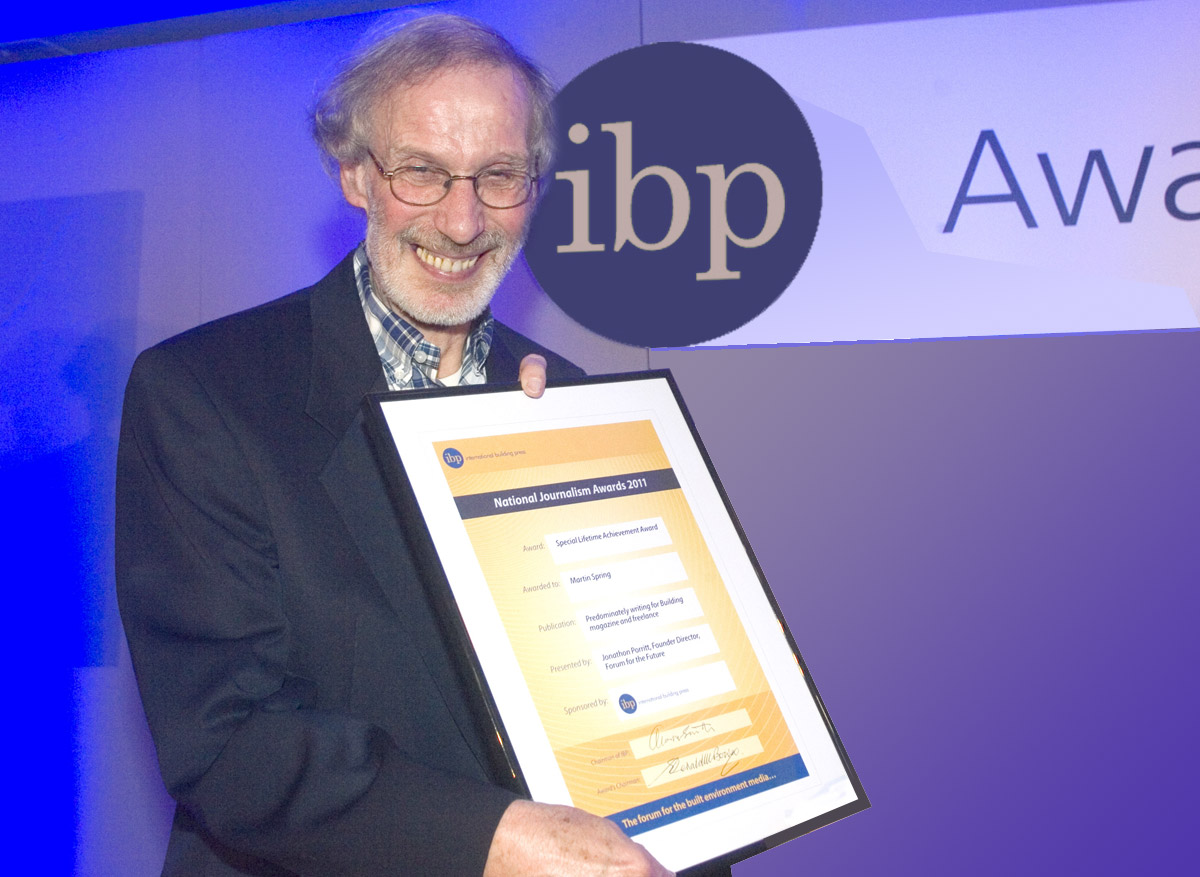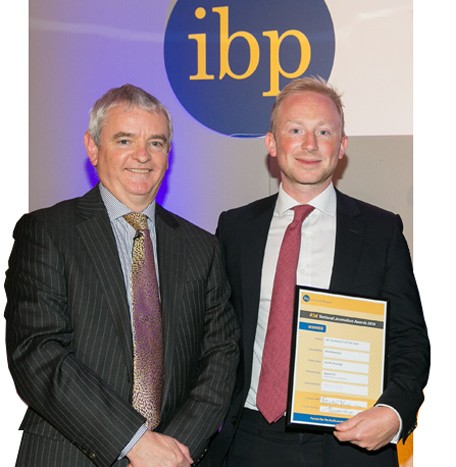Martin Spring: An Appreciation
Above: Martin was awarded a life time achievement award by IBP in 2011. The delight on his face is there for all to see.
For further details of funeral and memorial arrangements please email sarah.richardson@ubm.com
I first met Martin in the early 1980’s when I was the director of The Campaign for Traditional Housing. I was immediately attracted to his acerbic sense of humour, which lasted well into the digital age with his email critiques of the annual journalism awards. It was unanimous when IBP decided to give Martin a life time achievement award in 2011, only the fourth awarded in 47 years.
It was also a delight when Martin agreed to become a judge of the architecture and young journalist categories in 2013; As expected he brought his usual vast knowledge and forensic approach to the role, often ensuring his panel of judges worked well into overtime to achieve the right results!
I am most grateful to Martin’s friends and colleagues for the following shared memories.
Gerald Bowey
Denise Chevin, former editor, Building, remembers Martin
Those of us who worked and knew Martin Spring have been shocked and saddened to hear of his passing aged 70.
Martin was a much loved journalist with his own unique style which won him 14 IBP awards over his 33-year career as Building’s architectural editor. But above all, he was a gentle and humble man, possessed of a remarkably cheerful and sunny outlook on life, who lived and breathed his subject and imparted that enthusiasm to many others.
His architectural tours on Building days out, with their carefully selected pub stops along the way, were legendary – the intelligence and deep knowledge conveyed in his commentaries opening many colleagues’ eyes to unexpected facets of the subject.
And he was always happy to help and guide. Former Building colleague Jo Smit recalls the assistance he gave her when she began there: “Martin was a tremendous help, and gave me a much deeper understanding of what ‘good’ means in architecture.”
For myself, I remember being more than a little in awe of him when I joined Building as a novice technical writer. His wit and elegance of phrase and the thoroughness with which he tackled every writing assignment left a deep impression on me, as did his patient willingness to explain and educate- particularly over a few drinks at the local Docklands watering hole where the magazine was based at the time.
Says former colleague Graham Ridout: “Martin was as passionate about putting into words his love of building and architecture as he was about sharing thoughts and knowledge with others, especially those who were new to journalism or who were covering the subject for the first time. His encyclopaedic knowledge and the way he
explained things in that gentle, kind and helpful way was an inspiration to numerous colleagues, many of whom went on to be outstanding journalists.
“Martin was a true gentleman in both senses of the word and his passing is a sad loss to everyone who knew him or who was inspired by him."
Mark Leftly, another former colleague, also recalls his kindness to young, aspiring journalists. “He was exceptionally kind to me when I started out at Building, despite our age gap of 33 years. He pointed out what I was doing right, without prompting, at a time I was unsure of my work. My family got to know him too and will miss him just as dearly as we all will.”
In terms of his approach to architectural reviews, Thomas Lane, writing his obituary in Building, puts it well: “His rounded approach ensured his articles had something for everyone whether architect, contractor or cost consultant. He was always complimentary about the schemes he wrote about and was very supportive of emerging architects, sticking by these firms for many years
“His writing was rooted in the practical belief that architecture was principally about how well a building performed for occupiers, energy efficiency, procurement (including delivering on time and to budget), with style some way down the list. He wasn’t interested in chasing down the latest starchitect-designed triumph of style over substance; instead he preferred quiet considered buildings by the likes of Bennetts Associates, Cullinan Studio and Fielden Clegg Bradley.
“He was a great advocate of sustainability long before it became a mainstream concern and was also passionate about housing design. One of his specialities was the revisit, where he went back to a previously featured building some years later to see what occupiers
thought of it, how it was holding up and how much energy it was using.”
Eleanor Young, RIBA Journal deputy editor agrees: ‘Martin operated in the journalistic crossover between construction and architecture but for those in architecture it was always clear where his preference lay, in the end result and how the designs got realised.”
Martin’s approach to architecture earned him an honorary RIBA Fellowship in 2003 and his ability to adopt a holistic approach to writing about buildings won him IBP awards not just in the architectural category but for the housing and construction categories too.
IBP Awards Night features large in the recollections of many of Martin’s colleagues. Says former editor Peter Bill: “I can see us all now, sat on the Building table at the IBP awards feeling anxious - except for Martin, who was always relaxed. The winners would be announced, and there would be fixed smiles and reluctant applause if anyone on a rival title won anything. Except from Martin, whose smile and applause was genuine.
“And rivals would share in that pleasure when Martin won – as he did with such regularity that it was almost taken for granted he would add to Building’s tally each year. Why? Because he was the best writer of his generation at providing an understanding of merits of architecture to sceptical readers of Building.”
Martin was certainly thorough, in everything he did – too thorough at times, with the consequence that some projects took an age – like refurbishing his own house in Highbury, where he happily lived without cupboard doors for years.
I remember him too for his mischievous sense of fun, as well as his other worldliness. He was never a conformist. He’d often regale us with stories of his time as squatter in Covent Garden in the 1960s. And there was his determination to travel everywhere on his beloved bike (even after one too many refreshments). His acerbic one-liners at the Christmas party also come quickly to mind, as does his cardinal sin of wearing double denim. He never took himself too seriously, and remained resolutely young at heart. He will be very sorely missed by his many friends and family.
Peter Murray, friend and colleague, writes:
Martin was a lovely man. Kind and gentle, he nevertheless exhibited an inner steel and stubbornness when occasion required. I knew Martin almost all my working life: in the early 70s he came to work at Architectural Design where I was Technical Editor under the redoubtable Monica Pidgeon. He had started to study architecture at the AA but, like me, had found writing about it more to his liking than doing it.
I vividly remember that when he arrived in the AD office he had recently had a nasty fall from his bike and had gravel embedded in the side of his face. The accident didn’t put him off riding and my mental picture of Martin is of him with his trusty steel tourer with drop handlebars and old fashioned saddlebag. The gravel faded but never fully disappeared.
Monica Pidgeon was not an easy person to work with; she could be volatile and pretty blunt, but Martin held his own and they worked well together after I left to join BD through the difficult period of the three day week, plummeting revenues and subscriptions.
At the time AD was the leading - probably the only - UK architectural magazine that was taking building sustainability issues seriously. There were regular issues on energy conservation (CO2 problems had not yet been identified), on solar energy and recycling focusing on the work of heroic figures like Alex Pike at Cambridge and Gerry Foley at the AA and with close links to Friends of the Earth and writers like E F Schumacher (Small is Beautiful).
In 1975 the owners of AD, the Standard Catalogue Company were keen to sell the loss making magazine and Martin got together with the assistant editor Haig Beck and relaunched it. It was not a happy partnership - they joined up with the publisher Andreas Papadakis, disagreed on direction and Martin left, feeling cheated by Beck and Papadakis under whom the magazine was transformed into the bible of Post Modernism.
Martin exited to the more stable and pragmatic environment of Building where he remained for 33 years until 2009. He regularly produced high quality reportage and comment on new buildings, as well as revisiting older ones to see how they were working. He was a craftsman. His comment was measured, his style was, like the man, quiet but incisive and his analyses forensic. He never lost his interest in sustainability and the belief that buildings were to be used rather than just looked at. He was a faithful member of IBP and won 14 Journalism Awards during his career at Building
Ron Sidell, Founder Partner, Sidell Gibson Ltd adds:
How does one calculate the immense contribution made to the world of architecture by Martin - the consummate reviewer and critic. Knowing him as I did for a period of some forty years I came to appreciate not only the exceptional calibre of his writing, but his enthusiasm for new adventures. It was with great pleasure that we presented the IBP award for Architectural Writer of the Year, on several occasions, to this modest and self-effacing man. It would never have occurred to him how hard an act he would be to follow.
Above: Martin was awarded a life time achievement award by IBP in 2011. The delight on his face is there for all to see.
For further details of funeral and memorial arrangements please email sarah.richardson@ubm.com
I first met Martin in the early 1980’s when I was the director of The Campaign for Traditional Housing. I was immediately attracted to his acerbic sense of humour, which lasted well into the digital age with his email critiques of the annual journalism awards. It was unanimous when IBP decided to give Martin a life time achievement award in 2011, only the fourth awarded in 47 years.
It was also a delight when Martin agreed to become a judge of the architecture and young journalist categories in 2013; As expected he brought his usual vast knowledge and forensic approach to the role, often ensuring his panel of judges worked well into overtime to achieve the right results!
I am most grateful to Martin’s friends and colleagues for the following shared memories.
Gerald Bowey
Denise Chevin, former editor, Building, remembers Martin
Those of us who worked and knew Martin Spring have been shocked and saddened to hear of his passing aged 70.
Martin was a much loved journalist with his own unique style which won him 14 IBP awards over his 33-year career as Building’s architectural editor. But above all, he was a gentle and humble man, possessed of a remarkably cheerful and sunny outlook on life, who lived and breathed his subject and imparted that enthusiasm to many others.
His architectural tours on Building days out, with their carefully selected pub stops along the way, were legendary – the intelligence and deep knowledge conveyed in his commentaries opening many colleagues’ eyes to unexpected facets of the subject.
And he was always happy to help and guide. Former Building colleague Jo Smit recalls the assistance he gave her when she began there: “Martin was a tremendous help, and gave me a much deeper understanding of what ‘good’ means in architecture.”
For myself, I remember being more than a little in awe of him when I joined Building as a novice technical writer. His wit and elegance of phrase and the thoroughness with which he tackled every writing assignment left a deep impression on me, as did his patient willingness to explain and educate- particularly over a few drinks at the local Docklands watering hole where the magazine was based at the time.
Says former colleague Graham Ridout: “Martin was as passionate about putting into words his love of building and architecture as he was about sharing thoughts and knowledge with others, especially those who were new to journalism or who were covering the subject for the first time. His encyclopaedic knowledge and the way he
explained things in that gentle, kind and helpful way was an inspiration to numerous colleagues, many of whom went on to be outstanding journalists.
“Martin was a true gentleman in both senses of the word and his passing is a sad loss to everyone who knew him or who was inspired by him."
Mark Leftly, another former colleague, also recalls his kindness to young, aspiring journalists. “He was exceptionally kind to me when I started out at Building, despite our age gap of 33 years. He pointed out what I was doing right, without prompting, at a time I was unsure of my work. My family got to know him too and will miss him just as dearly as we all will.”
In terms of his approach to architectural reviews, Thomas Lane, writing his obituary in Building, puts it well: “His rounded approach ensured his articles had something for everyone whether architect, contractor or cost consultant. He was always complimentary about the schemes he wrote about and was very supportive of emerging architects, sticking by these firms for many years
“His writing was rooted in the practical belief that architecture was principally about how well a building performed for occupiers, energy efficiency, procurement (including delivering on time and to budget), with style some way down the list. He wasn’t interested in chasing down the latest starchitect-designed triumph of style over substance; instead he preferred quiet considered buildings by the likes of Bennetts Associates, Cullinan Studio and Fielden Clegg Bradley.
“He was a great advocate of sustainability long before it became a mainstream concern and was also passionate about housing design. One of his specialities was the revisit, where he went back to a previously featured building some years later to see what occupiers
thought of it, how it was holding up and how much energy it was using.”
Eleanor Young, RIBA Journal deputy editor agrees: ‘Martin operated in the journalistic crossover between construction and architecture but for those in architecture it was always clear where his preference lay, in the end result and how the designs got realised.”
Martin’s approach to architecture earned him an honorary RIBA Fellowship in 2003 and his ability to adopt a holistic approach to writing about buildings won him IBP awards not just in the architectural category but for the housing and construction categories too.
IBP Awards Night features large in the recollections of many of Martin’s colleagues. Says former editor Peter Bill: “I can see us all now, sat on the Building table at the IBP awards feeling anxious - except for Martin, who was always relaxed. The winners would be announced, and there would be fixed smiles and reluctant applause if anyone on a rival title won anything. Except from Martin, whose smile and applause was genuine.
“And rivals would share in that pleasure when Martin won – as he did with such regularity that it was almost taken for granted he would add to Building’s tally each year. Why? Because he was the best writer of his generation at providing an understanding of merits of architecture to sceptical readers of Building.”
Martin was certainly thorough, in everything he did – too thorough at times, with the consequence that some projects took an age – like refurbishing his own house in Highbury, where he happily lived without cupboard doors for years.
I remember him too for his mischievous sense of fun, as well as his other worldliness. He was never a conformist. He’d often regale us with stories of his time as squatter in Covent Garden in the 1960s. And there was his determination to travel everywhere on his beloved bike (even after one too many refreshments). His acerbic one-liners at the Christmas party also come quickly to mind, as does his cardinal sin of wearing double denim. He never took himself too seriously, and remained resolutely young at heart. He will be very sorely missed by his many friends and family.
Peter Murray, friend and colleague, writes:
Martin was a lovely man. Kind and gentle, he nevertheless exhibited an inner steel and stubbornness when occasion required. I knew Martin almost all my working life: in the early 70s he came to work at Architectural Design where I was Technical Editor under the redoubtable Monica Pidgeon. He had started to study architecture at the AA but, like me, had found writing about it more to his liking than doing it.
I vividly remember that when he arrived in the AD office he had recently had a nasty fall from his bike and had gravel embedded in the side of his face. The accident didn’t put him off riding and my mental picture of Martin is of him with his trusty steel tourer with drop handlebars and old fashioned saddlebag. The gravel faded but never fully disappeared.
Monica Pidgeon was not an easy person to work with; she could be volatile and pretty blunt, but Martin held his own and they worked well together after I left to join BD through the difficult period of the three day week, plummeting revenues and subscriptions.
At the time AD was the leading - probably the only - UK architectural magazine that was taking building sustainability issues seriously. There were regular issues on energy conservation (CO2 problems had not yet been identified), on solar energy and recycling focusing on the work of heroic figures like Alex Pike at Cambridge and Gerry Foley at the AA and with close links to Friends of the Earth and writers like E F Schumacher (Small is Beautiful).
In 1975 the owners of AD, the Standard Catalogue Company were keen to sell the loss making magazine and Martin got together with the assistant editor Haig Beck and relaunched it. It was not a happy partnership - they joined up with the publisher Andreas Papadakis, disagreed on direction and Martin left, feeling cheated by Beck and Papadakis under whom the magazine was transformed into the bible of Post Modernism.
Martin exited to the more stable and pragmatic environment of Building where he remained for 33 years until 2009. He regularly produced high quality reportage and comment on new buildings, as well as revisiting older ones to see how they were working. He was a craftsman. His comment was measured, his style was, like the man, quiet but incisive and his analyses forensic. He never lost his interest in sustainability and the belief that buildings were to be used rather than just looked at. He was a faithful member of IBP and won 14 Journalism Awards during his career at Building
Ron Sidell, Founder Partner, Sidell Gibson Ltd adds:
How does one calculate the immense contribution made to the world of architecture by Martin - the consummate reviewer and critic. Knowing him as I did for a period of some forty years I came to appreciate not only the exceptional calibre of his writing, but his enthusiasm for new adventures. It was with great pleasure that we presented the IBP award for Architectural Writer of the Year, on several occasions, to this modest and self-effacing man. It would never have occurred to him how hard an act he would be to follow.
























